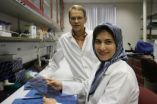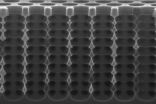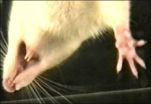(Press-News.org) An African mosquito species with a deadly capacity to transmit malaria has a perplexing evolutionary history, according to discovery by researchers at the Fralin Life Science Institute at Virginia Tech.
Closely related African mosquito species originated the ability to transmit human malaria multiple times during their recent evolution, according to a study published this week in PLoS Pathogens by Igor Sharakhov, an associate professor of entomology in the College of Agriculture and Life Sciences, and Maryam Kamali of Tehran, Iran, a Ph.D. student in the department of entomology.
The discovery could have implications for malaria control by enabling researchers to detect and target specific genetic changes associated with the capacity to transmit a parasite.
Malaria causes as many as 907,000 deaths each year, mostly among children in sub-Saharan Africa. Anopheles mosquitoes, which bite mainly between dusk and dawn, transmit human malaria by spreading Plasmodium parasites that multiply in the human liver and infect red blood cells. But of the more than 400 species of mosquito belonging to the Anopheles genus, only about 20 are effective vectors of human malaria, according to the World Health Organization.
The most dangerous of these is the Anopheles gambiae mosquito species, one of seven in the Anopheles gambiae complex, which was thought to have recently evolved the ability to transmit malaria. However, Virginia Tech scientists' discoveries suggest that this species is actually genetically linked to an older, ancestral lineage.
Scientists used chromosomal analysis to compare gene arrangements for mosquitoes both inside and outside the Anopheles gambiae family to trace the evolutionary connections.
"The outside species served as a reference group for understanding the evolutionary relationship among Anopheles gambiae mosquitoes," Kamali said. "Our goal was to determine how different species arose in the Anopheles gambiae complex, as they all look identical, but have different behaviors and capacities to transmit human malaria."
When resolving the Anopheles gambiae evolutionary history, the scientists identified breaks in DNA that lead to new chromosomal arrangements, and used these rearrangements to demonstrate the repeated evolution of the ability to transmit a parasite, in a back-and-forth fashion.
"This curious stop-and-go flexibility could help us to better understand the nature of the mosquito's capacity to transmit malaria, and calls into question what is driving the genetic flexibility," Sharakhov said.
The discovery is innovative in the field of genetics research.
"The surprising aspect of the paper is the proposal of an ancestral and relatively ancient 2La polymorphism which arose in a hypothetical ancestor and has been maintained in Anopheles gambiae ever since," said Nora Besansky, the Rev. John Cardinal O'Hara C.S.C. professor of biological sciences at the University of Notre Dame, who was not involved in the study. "If confirmed, this would certainly lend novel insight into the evolutionary dynamics of chromosomal inversions in general, not only in mosquitoes."
INFORMATION:
The research was reported in PLoS Pathogens on Oct. 4. Ai Xia, a former Ph.D. student of Sharakhov, and Zhijian Tu, professor of biochemistry in the College of Agriculture and Life Sciences, are co-authors.
Mosquito genetics may offer clues to malaria control, Virginia Tech researchers say
Fralin Life Science Institute scientists pinpoint curious genetic trait behind malaria transmission
2012-10-05
ELSE PRESS RELEASES FROM THIS DATE:
Building 3-D structures from a 2-D template
2012-10-05
This press release is available in German.
Deep below the silicon surface, the SPRIE method produces regular structures in the micrometer range that refract light. (Photo: KIT/CFN)
In modern telecommunications, light carries digital information over kilometers within seconds. Adapted optical materials control the light signals. In the AFM journal, researchers from Berlin, Louvain, and from Karlsruhe Institute of Technology present a method to produce photonic crystals. Their optical properties are adjusted by structures of micrometer size. The method is rapid, cheap, ...
Low incidence of needlestick injuries among staff at national pharmacy chain
2012-10-05
CHICAGO (October 5, 2012) – Vaccinations for flu, tetanus and other common vaccines are increasingly taking place in non-medical settings such as supermarkets and drug stores. This added responsibility for pharmacists increases the risk of needlestick injuries (NSIs), puncture wounds often suffered while preparing or after use of a needle. NSIs can transmit bloodborne pathogens, including hepatitis C and HIV, from an infected patient to the person administering the vaccine.
A new report published in the November issue of Infection Control and Hospital Epidemiology, the ...
Genotyping helps identify source of clinic infection outbreak
2012-10-05
CHICAGO (October 5, 2012) – Researchers from East Carolina University used a new technique of genotyping to identify the source of a hematology clinic outbreak of Mycobacterium mucogenicum, a gram-positive, acid-fast bacteria found in tap water. This is the first outbreak of M. mucogenicum in an ambulatory care setting; five other outbreaks have been reported in hospital settings since 1995. The study was published in the November issue of Infection Control and Hospital Epidemiology, the journal of the Society for Healthcare Epidemiology of America.
Using repetitive ...
MIT Research: What number is halfway between 1 and 9? Is it 5 -- or 3?
2012-10-05
CAMBRIDGE, Mass. — Ask adults from the industrialized world what number is halfway between 1 and 9, and most will say 5. But pose the same question to small children, or people living in some traditional societies, and they're likely to answer 3.
Cognitive scientists theorize that that's because it's actually more natural for humans to think logarithmically than linearly: 30 is 1, and 32 is 9, so logarithmically, the number halfway between them is 31, or 3. Neural circuits seem to bear out that theory. For instance, psychological experiments suggest that multiplying the ...
How will smart cars affect the future of driving?
2012-10-05
California, Nevada, and Florida have already made driverless cars street-legal, and continuing advances in the technology have led many to predict that the commercialization of automated vehicles is a real possibility in the not-so-distant future. As driverless vehicles become more commonplace, it is important to understand how humans interact with this new technology. The Human Factors special issue on automation, featuring the latest articles on designing automated vehicles with the driver in mind, is now available online. The October 2012 issue may be found at http://hfs.sagepub.com/content/current. ...
'Disgusted' rats teaching scientists about nausea, work may lead to new cancer treatments
2012-10-05
Nausea is a common and distressing side effect of many drugs and treatments. Unlike vomiting, nausea is not well understood, but new research by University of Guelph scientists may soon change that.
Guelph PhD student Katharine Tuerke, neuroscience researcher Cheryl Limebeer and Prof. Linda Parker in the Department of Psychology believe they've found the mechanism in the brain that is responsible for the sensation of nausea – with the help of some "disgusted" rats.
Their study was published this week in Journal of Neuroscience.
"Although everyone has experienced ...
Tree nut research may unexpectedly lead to medical advances
2012-10-05
This press release is available in Spanish.
Prescription drugs that today help patients fight severe fungal infections might tomorrow be even more effective, thanks to unexpected findings from agriculture-based, food-safety-focused studies by U.S. Department of Agriculture (USDA) scientists and their colleagues.
Petri-dish experiments conducted by now-retired USDA Agricultural Research Service (ARS) research leader Bruce C. Campbell, ARS molecular biologist Jong H. Kim, and their co-investigators suggest that pairing conventional antifungal medicines with natural, edible ...
NASA notes Nadine now no more
2012-10-05
Twenty-three days after Nadine was born, the tropical cyclone's life came to an end in the northeastern Atlantic Ocean. NASA's TRMM satellite caught a look at the fading Nadine one final time on Oct. 3 before it dissipated.
NASA's Tropical Rainfall Measuring Mission (TRMM) satellite passed above long-lasting Nadine for the last time before the tropical storm's dissipation on October 4, 2012 at 0249 UTC (10:49 p.m. EDT October 3, 2012).
TRMM measures rainfall from space and there was very little remaining in Nadine when it passed overhead. Rainfall data from TRMM's Microwave ...
NASA satellites indicate wind shear taking toll on Oscar
2012-10-05
Satellite data is showing that northwesterly wind shear is taking a toll on Tropical Storm Oscar in the central Atlantic and it is expected to dissipate the storm late on Oct. 5, 2012.
NASA's Aqua satellite passed over Tropical Storm Oscar on Oct. 4 at 1335 UTC (9:35 a.m. EDT) and the Moderate Resolution Imaging Spectroradiometer (MODIS) instrument captured a true-color image of the storm. The imagery showed bulk of Oscar's clouds and showers were southeast of the center of circulation as a result of wind shear.
On Oct. 5 at 5 a.m. EDT, Oscar's maximum sustained winds ...
Scratching the surface: Stanford engineers examine UV effects on skin mechanics
2012-10-05
Reinhold Dauskardt, PhD, of Stanford's Department of Materials Science and Engineering has been studying skin for years. But when he sent his students to look for data on the mechanical properties of skin, they came back empty-handed. A lot was known about skin structure and disease, but few papers actually talked about its mechanical function – its ability to stretch and resist tension without tearing. "That motivated us to get more interested in the skin itself," said Dauskardt.
He and his team, including Ph.D. student Krysta Biniek and postdoctoral researcher Kemal ...
LAST 30 PRESS RELEASES:
Making lighter work of calculating fluid and heat flow
Normalizing blood sugar can halve heart attack risk
Lowering blood sugar cuts heart attack risk in people with prediabetes
Study links genetic variants to risk of blinding eye disease in premature infants
Non-opioid ‘pain sponge’ therapy halts cartilage degeneration and relieves chronic pain
AI can pick up cultural values by mimicking how kids learn
China’s ecological redlines offer fast track to 30 x 30 global conservation goal
Invisible indoor threats: emerging household contaminants and their growing risks to human health
Adding antibody treatment to chemo boosts outcomes for children with rare cancer
Germline pathogenic variants among women without a history of breast cancer
Tanning beds triple melanoma risk, potentially causing broad DNA damage
Unique bond identified as key to viral infection speed
Indoor tanning makes youthful skin much older on a genetic level
Mouse model sheds new light on the causes and potential solutions to human GI problems linked to muscular dystrophy
The Journal of Nuclear Medicine ahead-of-print tip sheet: December 12, 2025
Smarter tools for peering into the microscopic world
Applications open for funding to conduct research in the Kinsey Institute archives
Global measure underestimates the severity of food insecurity
Child survivors of critical illness are missing out on timely follow up care
Risk-based vs annual breast cancer screening / the WISDOM randomized clinical trial
University of Toronto launches Electric Vehicle Innovation Ontario to accelerate advanced EV technologies and build Canada’s innovation advantage
Early relapse predicts poor outcomes in aggressive blood cancer
American College of Lifestyle Medicine applauds two CMS models aligned with lifestyle medicine practice and reimbursement
Clinical trial finds cannabis use not a barrier to quitting nicotine vaping
Supplemental nutrition assistance program policies and food insecurity
Switching immune cells to “night mode” could limit damage after a heart attack, study suggests
URI-based Global RIghts Project report spotlights continued troubling trends in worldwide inhumane treatment
Neutrophils are less aggressive at night, explaining why nighttime heart attacks cause less damage than daytime events
Menopausal hormone therapy may not pose breast cancer risk for women with BRCA mutations
Mobile health tool may improve quality of life for adolescent and young adult breast cancer survivors
[Press-News.org] Mosquito genetics may offer clues to malaria control, Virginia Tech researchers sayFralin Life Science Institute scientists pinpoint curious genetic trait behind malaria transmission




